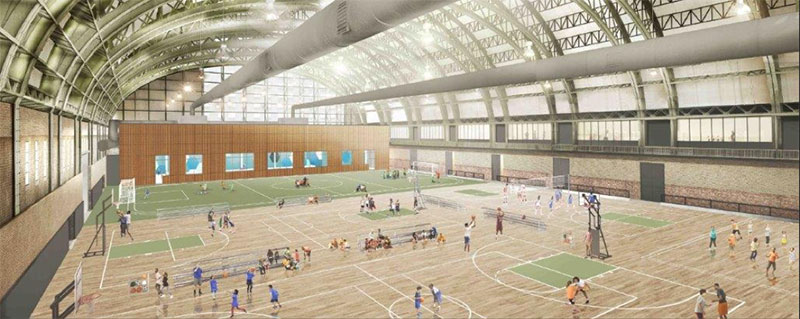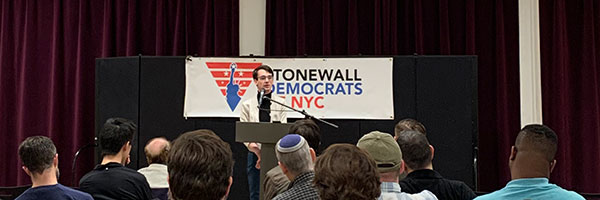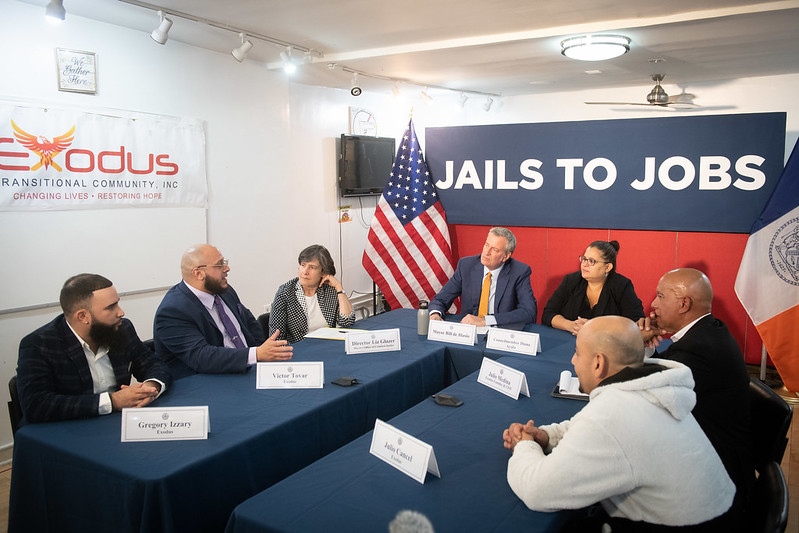At the Bedford-Union Armory, a Community’s Vision is Realized

Beford-Union Armory rendering
As one of Brooklyn’s most historic neighborhoods, Crown Heights is a cultural landmark and epicenter for creativity. For many that knew Brooklyn before the age of mega-development, Crown Heights was once home to many recreational spaces for youth and families. I remember growing up in the Crown Heights/East Flatbush section of Brooklyn with a variety of recreational outlets, from the Empire Roller Rink and Bedford Bowl to the Kenmore Movie Theatre to the Crown Heights Youth Collective and more. I always felt like I had somewhere to go.
From 2007 onward, the Crown Heights community has felt the impact of the absence of recreational spaces for young people, left without vital community resources to help navigate young adulthood. For over a decade, our youth have grown up without essential academic and recreational spaces to live, learn, and grow. Today we celebrate the symbolic resurgence of community in Crown Heights with the groundbreaking for the newly renovated Bedford-Union Armory.
Steeped in tradition and legacy, yet newly designed to meet the needs of all residents, this space will cultivate a new era for Crown Heights: restoring unity in the community.
For generations, activists and community organizers have argued that the community needs a vibrant recreational center to be utilized by all residents, and reflect the rich history of the neighborhood. As Central Brooklyn continues to change, it is becoming increasingly more difficult for cultural non-profits to find permanent, affordable spaces to flourish and grow within the community.
As of next year, the repurposed armory will serve as a multi-use facility with affordable housing, recreational space, arts, after-school programming, and more. This week’s groundbreaking is the first step toward realizing the vision that has united our community.
Currently under construction, the Bedford-Union Armory’s vast recreational space will include three hardwood basketball courts, a multi-sport field, and a six-lane swimming pool—all of which will be available to local families and students at nearby schools. When standing inside the armory, it does not take much imagination to envision a completed athletic facility bustling with the energy and excitement of students unwinding after a long day at school. Rooted in the Crown Heights community tradition, the armory builds on the forward-thinking vision of Congressional Rep. Major Owens and other community stakeholders envisioned by creating a neighborhood hub for activity.
Partnerships with groups like New Heights Youth will help empower local students to reach their full academic and personal potential. This organization, which will be housed in the classroom space of the new armory, works with young men and women with an interest in basketball. Their after-school program in Crown Heights will help students to complete their homework before hitting the courts. Since 2005, 100 percent of New Heights students have graduated high school, and 98 percent enroll in college.
With programming that bridges education, arts, athletics, and empowerment, we know that the armory will be a long-standing community center in our beloved neighborhood.
While the Armory’s recreation center will be a community gathering space, it is these non-profit tenants that prove most exciting. Many of those tenants, leasing space at $6 a square foot, are providing programming and services that will truly make a difference with Central Brooklyn’s youth.
Consider, for example, Ifetayo Cultural Arts Academy, the organization that provides African-centered rites of passage programming to over 2,000 students and their families, will take up a permanent space at the Bedford-Union Armory. It will expand to a seven-day-per-week program offering academic support and mentoring in addition to dance classes.
A similar story will unfold with Digital Girl Inc. The organization, which offers computer classes and other services for young women and men, now spends time in public schools, but also lacks a permanent home. When the armory opens its doors, it will have a complete computer lab that will operate seven days a week, making STEM programming the new norm, not an academic luxury for the elite.
There is so much more that could be said about the armory’s impact: over 29 nonprofits and athletic organizations will call it home when it is finished, plus the additional educational and enrichment programs that will utilize the common space and recreational activity. Each of these organizations are already impacting the community and now their efforts will be supported and amplified by the armory’s resources.
All in all, the redeveloped Bedford-Union Armory will offer services to the entire Crown Heights community with the recreation, performing arts, and after-school programming that it has deserved for generations. This week’s groundbreaking is merely the first step forward in this historic project of which all Central-Brooklynites can be proud.
***
City Council Member Laurie Cumbo represents parts of Brooklyn and is the majority leader of the Council. On Twitter @CMLaurieCumbo.
***
Have an op-ed idea or submission for Gotham Gazette? Email This email address is being protected from spambots. You need JavaScript enabled to view it.
Toward a Binary Free NYC

Emilia Decaudin, the author
For nearly 100 years, Democrats in the State of New York have elected one man and one woman per Assembly District to serve in the Democratic Party’s governing body, the State Committee. A rule change passed last month means that after 2020, this will no longer be the case.
Eleanor Roosevelt and the League of Women Voters pushed for gendered seats for party offices, which include State Committee, District Leader, and County Committee, in order to promote the participation of women in politics. In 2019, however, these rules mean that non-binary people—those who don’t identify as being exclusively either women or men—are, in most cases, barred from running for party office.
In order to solve this problem, I authored a resolution that passed at last month’s State Committee meeting that amends the rules of the New York Democratic Party in three important ways:
First, language that required two corresponding party officers, such as Secretary and Assistant Secretary, to be of “the opposite gender” has been changed to require they be of “different genders,” or both non-binary.
Second, language requiring gender “balance” on committee has been changed to not require members to identify as either women or men, while maintaining an equal number of the former.
Third, beginning on July 1, 2020, instead of electing “one male and one female” per Assembly District, Democrats will elect people of “different genders,” or who are both non-binary.
The resolution also adds gender and gender identity to the Party’s diversity clause and replaces gendered pronouns, such as “he or she,” with the singular “they.”
These changes will open up participation in the State Committee to a growing class of New Yorkers, while keeping in place the fundamental requirement for gender diversity that ensures that men don’t dominate party committees at the expense of women.
While this is important progress, this particular resolution only applies to the State Committee, which has no authority over the 62 County Committees in New York State. Many of those, including Brooklyn and Queens, have gendered County Committee seats, and all of them in New York City have gendered District Leader seats. These positions are arguably more important for the goal of inclusion, as most people break into the political party scene at the County Committee level.
Efforts are already underway in Manhattan and Brooklyn to remove gender requirements for District Leader and County Committee, respectively. (Manhattan doesn’t have gendered county committee seats, and Brooklyn District Leaders are coterminous with State Committee members.)
The first election for State Committee members under these new requirements will be in June of 2022. Before then, State Election Law must be changed in order to accommodate this new system. This is why I have also written a piece of legislation, sponsored by Assembly Member Richard Gottfried of Manhattan, who also sponsored the Gender Expression and Non-Discrimination Act (GENDA), in order to amend the way the Board of Elections handles elections for party positions to do just that.
The bill, which is slated to be introduced next session in Albany, changes the way all party positions for all political parties appear on the ballot. If a party has two vacancies for an office with gender requirements, instead of voting for one person in the male column and one person in the female column, voters will vote for two people in one column. Whoever gets the most votes wins one seat outright. Whoever gets the next most votes and is of the “opposite” gender or is of a different gender than the first candidate (depending on that party’s rules) also gets seated.
All of these granular changes to the way we elect candidates for party offices may seem insignificant at first. But they serve the important function of opening the door to participation by non-binary people preemptively and proactively, rather than waiting for them to knock on the door loudly and long enough for us to begrudgingly turn the lock.
Even then, there is more work to be done. Binary language that either formally or implicitly excludes non-binary people can be found in a myriad of places in our city—laws, regulations, press releases, signage, forms, and more. To tackle this issue, I’ve started Binary-Free NYC, which will serve as an umbrella for both the work being done at the party committee level and in other public forums. With any luck, New York State will continue to be a leader on gender diversity and inclusion.
****
Emilia Decaudin is a student and activist in New York City. She is the youngest and first openly transgender member of the New York State Democratic Committee, representing the 94th Assembly District in Westchester County. On Twitter @e_decaudin.
***
Have an op-ed idea or submission for Gotham Gazette? Email This email address is being protected from spambots. You need JavaScript enabled to view it.
Truly Equipping New York City to End Mass Incarceration and Close Rikers

(photo: Michael Appleton/Mayor's Office)
For decades, formerly and currently incarcerated New Yorkers -- along with mental health experts, legal advocates, and service providers -- have demanded that city officials find the courage to close Rikers Island jails once and for all, erasing a shameful stain on the legacy of a city that aspires to be the most progressive in the world. Due in part to the sweeping success of the #FREEnewyork campaign securing transformative pretrial reforms in Albany this year, New York City is on track to release over 900 New Yorkers from city jails ahead of a January deadline -- bringing us that much closer to shutting down Rikers, permanently.
In the past several months, we have seen fear-mongering opponents of criminal justice reform continue to spread myths about threats to public safety and the excessive costs of implementing these reforms, while advocates have not stopped fighting to uplift living examples of a better future.
In November 2018, RFK Human Rights Foundation launched the “Mass Bail Out” in collaboration with JustLeadershipUSA, VOCAL-NY, katal, and other grassroots advocacy organizations. This bail out operation lasted roughly one month and successfully freed 107 women and children from New York City jails. A major component of the bail out was the welcome center/resource tent that provided folks with information on housing and legal resources, a fresh toothbrush, a MetroCard, and a prepaid cellphone, among other things to ensure people had support when returning home.
Of the 107 people who were freed, 105 returned to their next court date— and these results are not unprecedented. Actions such as the nationwide Mama’s Day Bailout have produced incredible results that prove time and time again what impacted communities and organizers already know: capital and cages are not the best way to ensure return to court. Resources and support are.
On October 17, the New York City Council held a historic vote on the future of Rikers Island. This vote, and the organizing that influenced the Council to improve upon the mayor’s proposed plan, was passed alongside upwards of $260 million of investments into community-based solutions and resources outside of the justice system.
Since the #CLOSErikers campaign launched in 2016, advocates have made clear that many successful alternative responses to crime and punishment already exist in communities -- in New York and across the world -- but our city, state, and federal budgets have historically undervalued and under-utilized these practices in favor of expanding punitive responses and the carceral system.
The leaders of the #CLOSErikers campaign never lost sight of their broad vision to permanently shrink the jail system; improve conditions for anyone who remains incarcerated; and decarcerate through both legislative reforms and community investments. Survivors of Rikers Island and the City Council negotiated a thorough Points of Agreement document ahead of the land use vote for new jails to lay the groundwork for more investments under the #buildCOMMUNITIES platform and Roadmap for Mental Health Resources and Diversion.
As we prepare to welcome home thousands of New Yorkers, the de Blasio administration must guarantee they have access to all of the supports and non-restrictive programs that can truly help people thrive by meeting their needs. As advocates continue to advance their demands through hearing testimony and other direct action, on the Council end, we must hold the city administration accountable for delivering on post-release supports.
It is critical that the administration follows through on the $11.2 million commitment to 380 additional beds in the Justice Involved Supportive Housing program and change its federal HUD rule interpretations that have historically prevented New Yorkers who cycle in and out of city jails from being recognized as “chronically homeless” -- blatantly neglecting that their lack of housing or the shortage of programs that provide access to housing for justice-involved people is the reason they cannot find support or stability in their communities.
With bail reform implementation less than one month away, thousands of arrested New Yorkers will be released and sent back home to await their court dates in their communities where they belong. However, we have not truly delivered justice to these folks unless we provide them with the supports to ensure their success -- resources that help them and our entire city.
In October, we voted to put a deadline on the permanent closure of Rikers Island, while shrinking the citywide jail capacity over 75% in the next few years. We must continue to fight for the urgent and sensible investments that will ensure people return home to communities that are equipped to support them while also working to prevent people from coming into contact with the justice system in the first place.
We have to get this right the first time – the futures of thousands of New Yorkers, and really the city as a whole, depend on it. We must show the rest of the country, and the world, that we have the power to end mass incarceration while making our communities safer in the process and the will to continue fighting for the freedom and success of every New Yorker in every community.
***
City Council Member Antonio Reynoso represents parts of Brooklyn. Brandon J. Holmes is New York City Campaign Coordinator at JustLeadershipUSA. On Twitter @CMReynoso34 & @BJHolmes_NYC of @JustLeadersUSA
***
Have an op-ed idea or submission for Gotham Gazette? Email This email address is being protected from spambots. You need JavaScript enabled to view it.




